I opted for the Sport Classic transparent demonstrator, because that's how I roll. The Sport Classic range comes in additional opaque bodies such as dark blue, black, dark green and a few others. Additionally, there's another range called Ice Sport with transparent colored caps and sections (the barrel remains clear). Personally I'm not a big fan of colored demonstrators because if I want to use different ink colors they won't always match the color of the pen.
Body and materials
The body is well made and the plastic used is high quality. Kaweco makes the Sport range of fountain pens from other materials, some of them quite exotic. As you move up in price there's the aluminum version (at $70 and up) and even an aluminum-and-carbon fiber version ($100 and up). The Sport Classic is the cheapest, at $21. I got mine even cheaper, back when you could still find them at $14. Let me tell you one thing from the beginning: at $14 this pen is quite a steal. At $21 it is starting to encroach upon Lamy territory. So why aren't they sold at $14 anymore? It seems that Kaweco didn't like retailers to sell them so low so they imposed the $21 price.
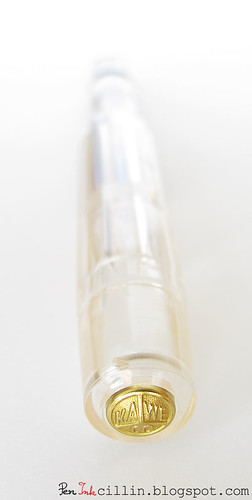
The Kaweco Sport pens come with nibs ranging from EF to BB. Mine is a B but that's only because when I bought mine there was no BB option.
The Kaweco Sport's tiny body consists of a round barrel and an 8-faceted cap which, as already mentioned, transforms this into a full-sized pen when posted. The cap also features a golden "Kaweco" logo at the tip. Inside the transparent cap there's a translucent inner cap. The cap itself is a screw-on type.
Some of the Kaweco Sport pens come with gold-plated nibs, while others have rhodium (silver) ones. This is dependent on body color. It seems that the Sport Classic range has golden nibs while the Ice Sport range has rhodium nibs. Transparent demonstrators like mine have the golden nib. Of course, it's not real gold. To be honest I think I would have preferred a silver nib especially since I've noticed some of the gold plating peeling off on the underside of the nib.
One thing that all the Kaweco Sport pens are missing is a clip. This makes them instantly unsuited for clipping to your shirt pocket. If you are worried that the pen might roll off your desk, don't be. It won't fall thanks to the aforementioned faceted cap. If you are hell-bent on clipping this pen, there's an optional and removable clip that you can purchase for about $4. In my opinion they should have included this clip in the pen's price.
Dimensions and weight
So the Kaweco Sport fountain pen starts out compact but extends to full-size with the cap posted. But what are some actual dimensions? Well, I have performed some measurements for you and here they are.
Length capped: 105mm / 4.13in
Length uncapped and un-posted: 102mm / 4in
Length of cap: 70mm / 2.75in
Length of nib: 17mm / 0.67in
Length with cap posted: 134mm / 5.28in
As you can see, the total length of the pen with the cap posted exceeds even that of the TWSBI Diamond 530 (un-posted of course).
As opposed to the TWSBI, the Kaweco Sport Classic is a very light pen. That can be good or bad, depending on your preferences. There's no denying, though, that an all-plastic construction lacking a more complex filling mechanism makes for a very light pen. Unfortunately I don't have a scale to give you some precise numbers.
Filling mechanism
The Kaweco Sport range is exclusively serviced by short cartridges of the international type. Don't expect any fancy piston or converter mechanism here. All pens come with a blue cartridge. At least I assume so, since mine did. Kaweco's blue is on the light side and nothing special to write home about.
Since I don't like to throw away cartridges, I have reused the original cartridge a few times. On one occasion I used Waterman Havana Brown, which wrote very nicely. On another, I used Noodler's Gruene Cactus Eel which left me rather unsatisfied.
I have come to loathe international cartridges, not just because they have a small capacity but mostly because the opening is very narrow and they are very hard to clean. In addition, ink droplets cling to the inner walls and they are very hard to shake off, essentially causing ink wastage.
Luckily, the Kaweco Sport pens can be easily converted to eyedroppers. I'm not so sure about the aluminum-bodied ones but the plastic pens are a cinch to convert. Simply apply a little silicon grease to the threads and fill the barrel with ink. By my measurements (with water), the barrel can hold exactly 3ml of liquid, which is quite a lot.
Personally I haven't performed the eyedropper conversion on this pen yet but the very next time I ink it up I will attempt it. The reason why I'm a bit reluctant to go the eyedropper route is that I like to change inks often and such a large capacity would require me to use the same color for many weeks since I don't get the chance to write by hand so much.
Nib and feed
As mentioned, the Sport Classic comes with gilded nibs. If the price weren't an indicator you could tell immediately that this isn't real gold (or even gold plating) by the too-intense yellow of the nib.
The nib itself is fairly handsome, with a filigree pattern, and the words "Germany" and "since 1883" stamped on either side of it. There's also a Kaweco logo and a B underneath.
The feed is a very basic plastic affair, with no visible fins. The fins are there though, but they are inside the section.
Both nib and feed are friction-fit inside the section. Unfortunately I haven't taken a picture of them removed but you can pull them out from the section for cleaning. Initially it might be harder to do so because they seem stuck but after the first time it becomes much easier. Putting the two back inside the section is easy. The nib is aligned to the feed by aid of some grooves running on each side of it. As such, it's almost impossible not to align the two exactly. When re-assembling, just push them into the section until they reach a dead stop and you are done.
Writing experience
I have noticed that bold nibs have different characteristics than their fine or medium cousins. A bold nib seems to be more needy in terms of ink supply. While the Kaweco Sport doesn't seem to have ink flow issues (at least not with a cartridge), the choice of ink can affect the writing experience.
There is no flex, bend or springiness in the nib.
Out of the three inks tested so far (Waterman Havana Brown, Noodler's Gruene Cactus Eel, and Kaweco blue), I enjoyed Havana Brown the most.
While the nib is smooth, there's something about it that bothers me a little. The only word I can find for it is "chalky". I can't put my finger on what causes this and it bears further investigation. Suffice to say that the nib doesn't glide across paper as silky smooth as I would like. I have no experience with Kaweco's other nib sizes so it could be a combination of the broad nib, along with the ink, along with the feed. As mentioned, Havana Brown seemed to work best in it.
One other thing that I've noticed is, after cleaning and drying the pen and starting anew, the nib skips a little at the beginning. Once the feed is properly saturated it writes normally. I have attempted to increase the flow by pulling a thin blade through the feed slit that goes underneath the nib. My pen isn't inked right now so I can't determine if the experiment worked.
Oh, I almost forgot. At the beginning of the article I said that the nib tends to lose its plating and this was certainly true in my case. When I removed the nib and feed the first time, there were golden flakes stuck to the feed. I cleaned those the best I could but that's not a good sign.
Overall I still consider the writing experience to be positive. All the signs point towards the pen being partial to certain types of ink but this hypothesis requires a lot more testing. I do enjoy the width of the line drawn by the broad nib. It really brings out the characteristics of a nice shading ink.
Wrap-up
The Kaweco Sport Classic is an affordable, nicely built, compact fountain pen with an interesting design which makes it light and portable. It offers some versatility in the ability to be converted to an eyedropper, in which case the ink capacity increases vastly over the standard international cartridge. It writes well, with the caveats mentioned but I believe that for best results it needs to be paired with the right ink. At $14 this pen is a good deal. At $14 including a clip, it becomes a great deal. However, at $21 + $4 for a clip I no longer see the value, and in fact I would much rather prefer a $28 Lamy Safari over the Kaweco Sport. If you go for the aluminum and/or carbon versions, the pricing becomes even more ludicrous. Personally I won't buy another Kaweco Sport unless the price drops but I am very glad I got mine when I had the chance to pay less.
Here's a sample written in Kaweco's own blue ink that comes with the included cartridge, on Rhodia 80g paper.

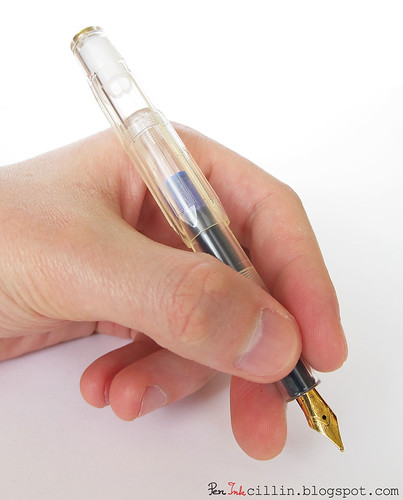
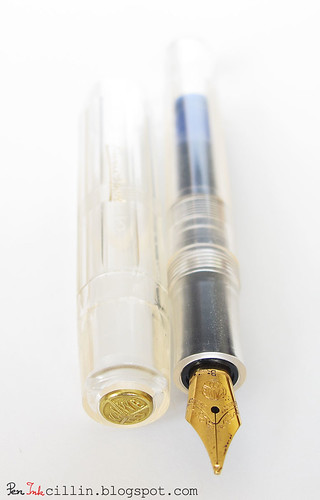
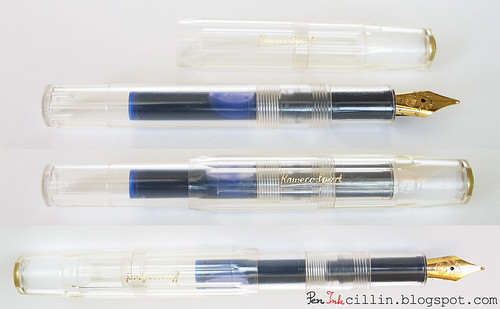
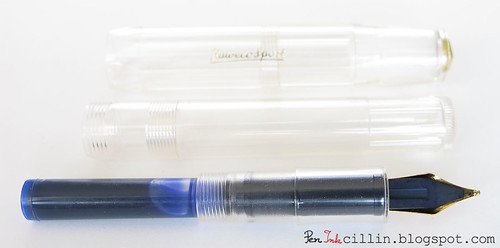
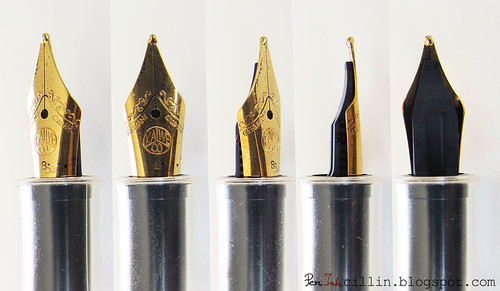
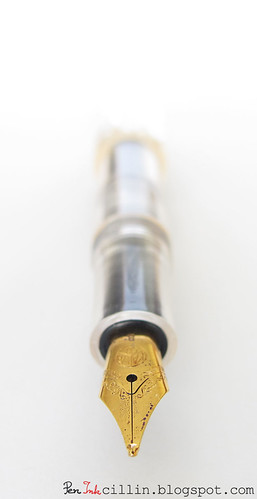
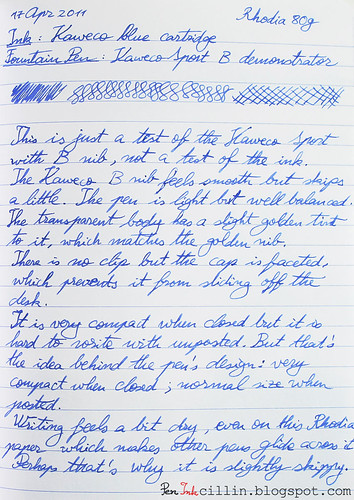
Awesomely thorough review!
ReplyDeleteThanks Brad!
ReplyDeleteWow. That is in-depth. Excellent work.
ReplyDeleteDear Peninkcillin !
ReplyDeleteVery useful and carefully prepared deep review. Thanks for your efforts.
I am a Kaweco addict with a broken heart at the beginning by buying from JetPens(1pc. second was apart) a two different color Kaweco Ice Sport. Because both of them has a scratchy nibs. I give them to the childrens of my friends as a gift.
later I bought
1pc. Sport Classic Black Gold M Nib
1pc. Alu-Carbon M Nib
1pc. Blue Chess Gold M nib
1pc Sport Art Celluloide Tortoise Gold M Nib
Gold plated nibs are very well polished and writes like ballet dancer on the well calendered paper. The only issue is ink capacity. And I made my special ink cartridge by cutting and gluing side by side two international small cartridge instead of converting Kaweco to an EyeDropper. And I am filling it with a syringe.
Its so painful to pay for a clip as you touched on your review. While I am buying my Kawecos I waited more than 3 weeks for gold clips.
Warm HUGS from Turkey
Thanks!
ReplyDeleteThanks Ali! Wow you must be a really BIG Kaweco fan. Why not buy any of the Lamy pens instead? Those seem much better value for money to me. At least they can use converters and their cartridges are much larger.
ReplyDeleteThanks for the detailed review.
ReplyDeleteThe dry weight of the Kaweco Sport, without cartridge, is 9.4 g.
I use it as an eyedropper without any gasket or grease--the thread is tight enough to prevent leaks. It holds about 2 ml of ink.
In Europe, the prices seem to be lower than those you show--about EUR 12 for this pen.
Cheers,
BT
Hi, I forgot to mention that you don't need a gasket for the eyedropper. Thanks for bringing that up. I filled mine all the way up to the threads and it held 3ml but I used an insulin syringe which is marked in units and I assumed that 100 units = 1ml.
ReplyDeleteThank you for the superb in depth review of the Kaweco Sport Classic pen. I had wanted a small pen like that for my shirt pocket but the lack of a clip was a deal breaker for me. Having to pay an additional $4.00 for a clip was not going to happen, certainly not for a pen like that.
ReplyDeleteUltimately, I opted for an Ohto Rook in orange and brushed aluminum and after a couple of days use have been pleased with it. At $16.50 (including clip!) it seems to be a better deal than the Kaweko Sport Classic.
As an aside, I discovered your site through Tyler Dahl's blogs and I'm glad I did...very nicely put together. :-)
Thank you Freddy! I'm really glad you liked the review. The Ohto Rook looks pretty cool but it doesn't have a broad nib. Who knows, I might pick one up at some point.
ReplyDeleteI'm beginning to think that I am the only person left who likes fine, even extra fine nibs, LOL.
ReplyDeleteWell, I started out liking F or EF nibs but then I started to drift towards B and even BB. The thicker, the better. The reason is because fine nibs don't really work well with light inks, nor do they allow the ink to show its shading properties.
ReplyDeleteAlso - and this may sound crazy - I like to waste ink. I like to use lots of it and change it often. I have a ton of ink samples that I want to review so a broad nib makes a lot of sense to me.
If you want to see a very fine nib, check out my review of the Sailor HighAce Neo. That nib is very fine and precise but it works best with dark inks.
Thanks for the review of the Sailor HighAce Neo. I just purchased a Pilot Penmanship with extra fine nib and it easily writes the thinnest line of any of my pens. I agree with you about these fine lines needing a darker ink and I have that Penmanship filled with Diamine Denim. It's a great combination.
ReplyDeleteI too like EF nibs, especially for note taking. I have a Kaweco Classic with an EF nib. I like the pen - carry it in my pants pocket - and the nib performs well with Noodlers Red Fox. The Kaweco EF nib writes a much broader line than my Cross Century XF nib, and I may yet send it off for some tuning.
ReplyDeletewow, i like the color of the nib. Its more of an 18k gold color! have you compared that to other Kaweco's nibs for comparisons?
ReplyDeleteActually I find the color too yellow to be confused with real gold. Unfortunately I don't have other Kaweco pens but their iridium nibs (regular silver colored) are just as normal as any other nib. Honestly I prefer silver nibs to the fake-gold ones.
ReplyDeleteA very thorough review! The fact this pen easily converts to an eyedropper is probably the #1 selling point of it. You weren't sure about the Al-Sport (aluminum version) being converted to an eyedropper....I wouldn't recommend it. Aluminum can react with a lot of inks, so you'll need to stick to cartridges alone for that pen.
ReplyDeleteThanks! Yeah, about the aluminum... I wouldn't risk it. I doubt any ink would eat through the metal but you never know what components are in inks and you might get oxidation or who knows what, which could cause other problems. Plastic is pretty much inert. I still haven't gotten around to converting mine. I hesitate because I like to change inks often and the huge capacity would prevent me from doing so.
ReplyDeleteI love these pens. I have one with a medium nib and plan to get one with a broad nib soon, as well as the extras, ink syringe etc from gouletpens for using it as an eyedropper (is that the term for filling it up in the barrel?).
ReplyDeleteHaving used it some more I'm not sure I would recommend the broad. With some inks it doesn't flow very well. I really wonder how a medium nib feels like. I bet it's not as dry as the broad.
ReplyDeleteThis is the one pen, under 30$, that I purchase consistently for myself and my English students as a prize for tasks well done in class for a number of reasons: No student I have ever given it to ever complains about it not working, they love how it writes on a variety of papers, and I keep so many different kinds of inks - they mix and match even - it takes the abuse.
ReplyDeleteIt is the highest quality starter pen I can recommend to to anyone.
That's pretty nice of you. I bet your students love you :) What nib size do you prefer?
ReplyDeleteCordyceps Sinensis
ReplyDeletehttp://feelgoodtime.net/what-is-cordyceps-sinensis-kordiceps-cordyceps-benefits-and-side-effects/
ReplyDeleteI am wondering if the Kaweco Student would work with a Kaweco 1.9 Calligraphy nib??? I believe there would be no problem fitting it with the Kaweco Classic, however I really like the student body and pen cap. Anyone have any thoughts or experience with the Kaweco Calligraphy nibs?
ReplyDeleteI'm not 100% certain but I believe they do fit.
ReplyDelete